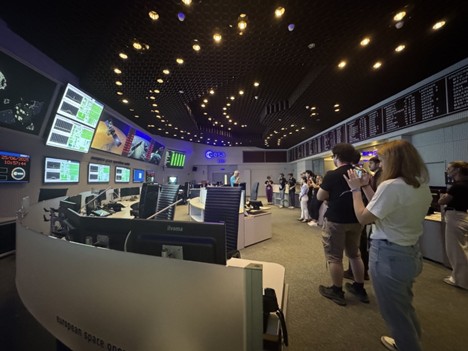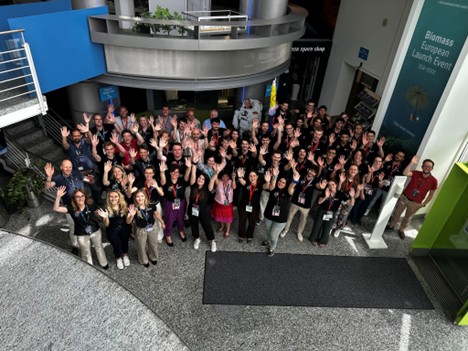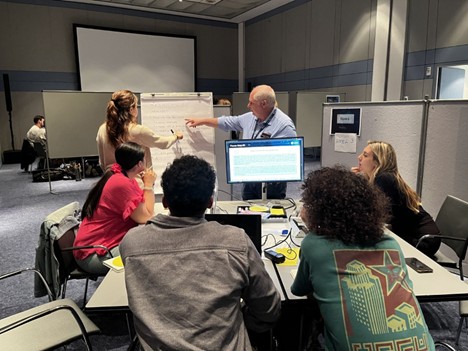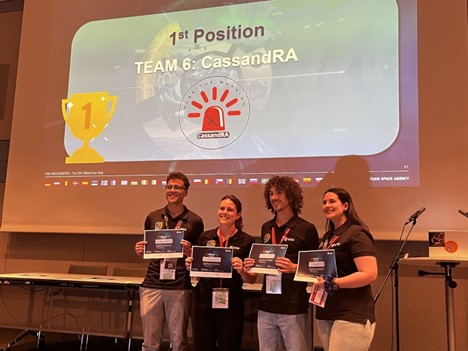The beginning of this summer marked the first ESA-hosted Space Weather hackathon, a pioneering event organised with strong involvement of the wider European Space Weather community. For the first time, the European Space Operations Centre (ESOC) hosted a dedicated gathering that brought together experts, students, and young professionals around a bold mission: Accelerate Space Weather Resilience. This event spotlighted some of the key challenges faced by mission operators when confronted by active space weather conditions, along with the growing momentum behind collaborative innovation in space data driven applications. It further emphasised the essential role of the next generation in shaping the future of space.
Held from June 23–25 at ESA’s ESOC facility in Darmstadt, Germany, the hackathon was hosted by the ESA Space Weather Office, with support from Sopra Steria and the ESA Education Office.

It brought together experts and service users from across the space weather community — including SES Satellites, ONERA, BIRA, ESA mission operators, and the ESA Space Weather Office team — to address critical challenges through innovation and teamwork.
The Accelerate Space Weather Resilience Hackathon also launched ESA Acceleration Days: a new series of in-person events designed to drive innovation in support of the ESA 2040 Strategy. With security and resilience as key pillars of Europe’s space ambition, this initiative aims to tackle the continent’s most pressing space-related challenges through creativity, collaboration, and forward-thinking solutions.
Context & Challenge
In line with the objectives of the Protect Accelerator – an initiative launched in 2021 by the ESA Director General under the Matosinhos Manifesto to “contribute to safeguarding and protecting European assets from (…) space weather interferences” – this hackathon was conceived as a platform for innovation and collaboration. It builds upon several recent findings and recommendations, including:
- The Space Weather Demonstrator Phase 1 report (April 2024), which highlighted the need for space weather services to be “easily accessible and user-tailored”.
- The outcomes of a Topical Discussion Meeting (TDM) held during the European Space Weather Week 2024 (ESWW) which emphasised a “clear need for boosting commercial dynamics”.
- The interim conclusions of the Space Weather Demonstrator Phase 2, which reflected on the spacecraft operations sector as showing the highest levels of awareness, exposure, and engagement to date.
Building on these, the hackathon was designed to encourage innovative collaboration and advance the development of user-focused, commercially viable space weather services. As reliance on space-based systems continues to expand, so does our collective exposure to space weather effects. In this context, space weather data represents a valuable resource—not only for safeguarding the increasing number of space assets, but also for enhancing the resilience of critical infrastructure on Earth.
To harness this potential, the event brought together 32 young innovators, grouped into seven teams and coming from nine countries, to develop bold, scalable solutions using real space weather data made available by the ESA Space Safety Programme, leveraging the experience of the ESA Space Weather Service Network. Each team tackled one of three focus areas:
Space Weather Control Room for Missions to the Solar System
Develop real-time visualisations of space weather conditions and assess their potential impact on selected solar system missions.
Post-Anomaly Investigation
Create tools or interfaces to support post-anomaly analysis using satellite telemetry, anomaly reports, and environmental data from both space- and ground-based sources.
Short-Term Notification & Alerting
Design real-time monitoring and alerting applications based on in-situ radiation and plasma data, enabling mission-specific alerts for spacecraft operators.


A key feature of the hackathon was the integration of newly available space weather data into each team’s solution. Participants were granted access to the ESA Space Weather Service Portal and a variety of real-time datasets to support their work.
Innovation Rewarded
Over three high-intensity days, the hackathon showcased a wide range of creative and technically advanced solutions across all focus areas. Each team tackled a unique “How Might We” (HMW) challenge, demonstrating their ability to leverage ESA’s space weather data alongside modern technologies such as AI, cloud computing, and user-centric design.

While all teams delivered impressive results, the winning solution, named CassandRA, stood out for its seamless integration of real-time data retrieval, forecasting, and decision modelling.
Featuring a user-centric interface powered by an API connection to key data sets, the CassandRA concept offers premium tools that support proactive decision-making. Its potential to prevent unexpected satellite shutdowns exemplifies the hackathon’s mission to advance space weather resilience through innovation.
As a reward, the winning team will have the opportunity to present their solution at European Space Weather Week 2025 (ESWW), one of the most renowned international space weather-focused events and the main event in the European space weather calendar, bringing together over 500 participants from academia, industry, and government. This presentation is not only a recognition of their work, but also a direct follow-up to the conclusions of discussion held during the ESWW 2024, which highlighted a “clear need for boosting commercial dynamics” in the space weather domain.
The team will contribute to a Topical Discussion Meeting (TDM) on innovation models for space weather services, where they will showcase their solution, explain their development process, and engage in a broader discussion on the potential role of hackathons and other rapid innovation events in the wider space weather landscape. This session will serve as a platform to reflect on the effectiveness of such formats and explore complementary or alternative innovation approaches to support the maturation and eventual operationalisation of space weather services in Europe.
Conclusion: A Launchpad for Innovation and Talent
The Accelerate Space Weather Resilience Hackathon was more than a standalone event—it was a concrete demonstration of how collaborative innovation can drive progress on high-level objectives like the ESA 2040 Strategy and the Matosinhos Manifesto.
By bringing together young professionals, students, and experts around real operational challenges, the event showcased the power of open data, fresh perspectives, and community engagement to shape Europe’s approach to space weather resilience.

Discussion: no comments